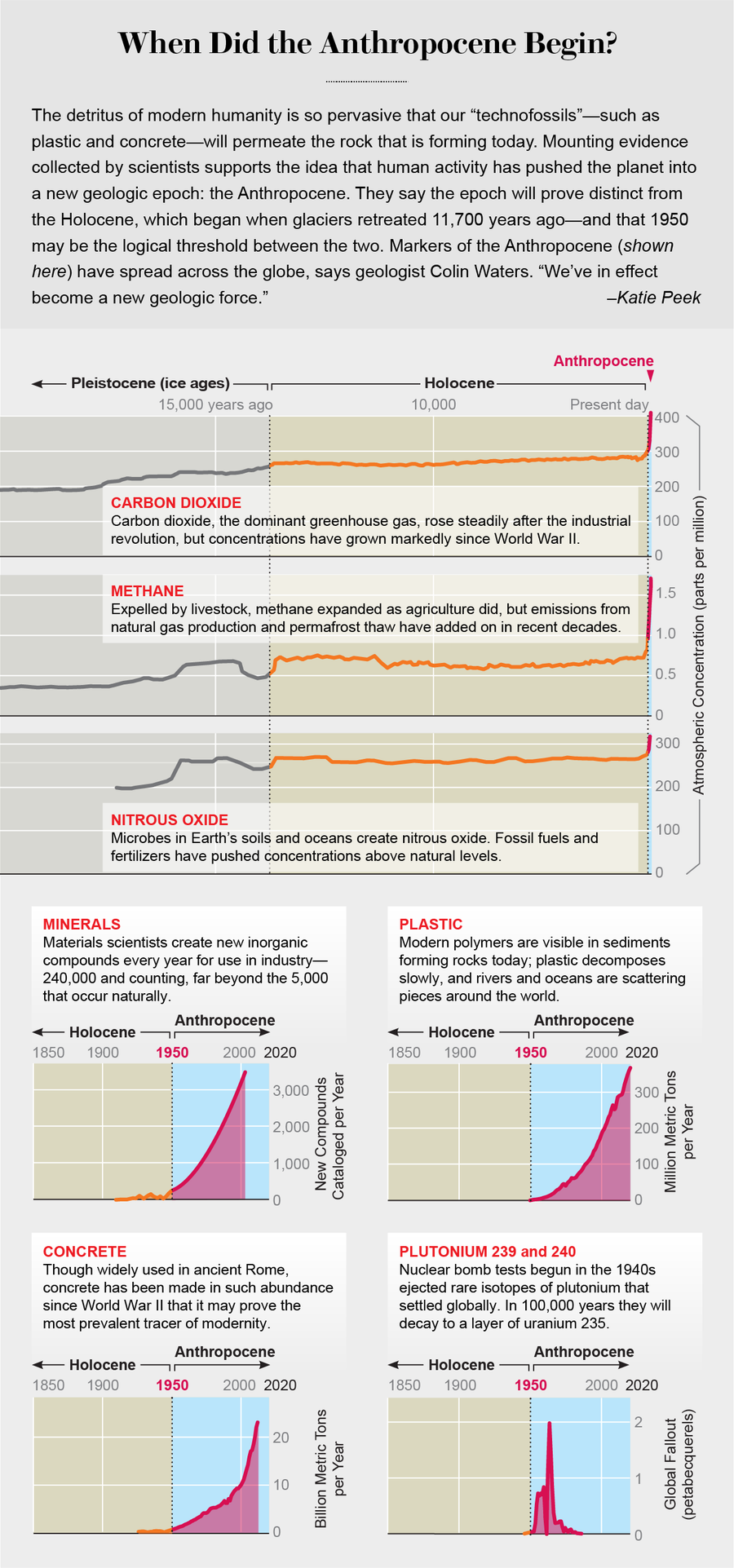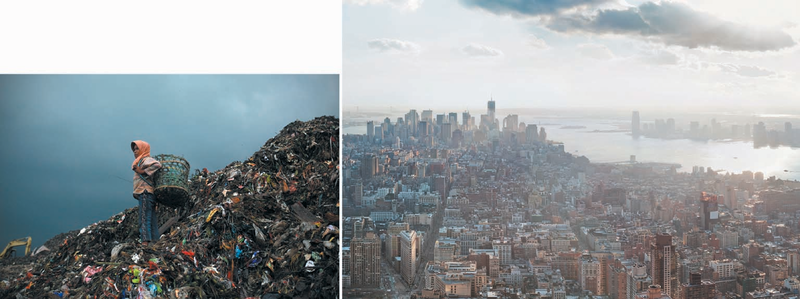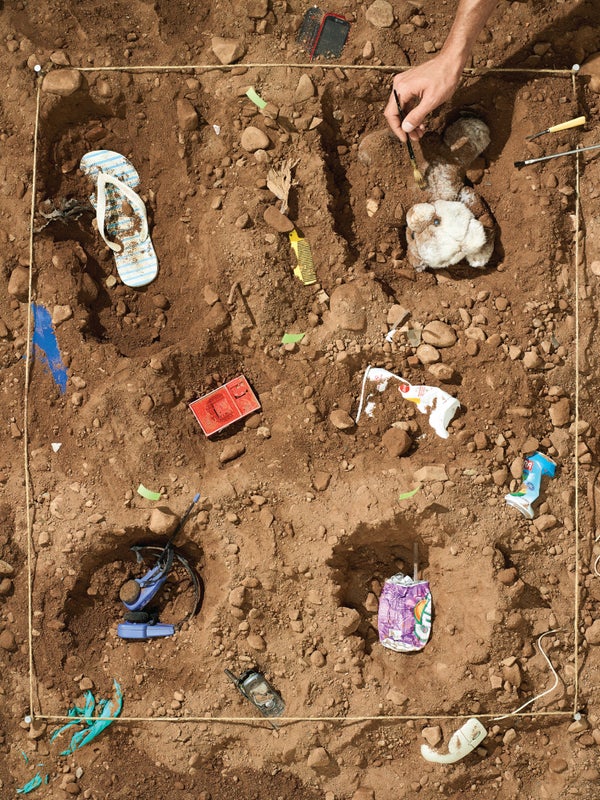The idea was born in Mexico, in the year 2000. It was pure improvisation by Paul Crutzen, one of the world's most respected scientists. The Dutch scholar was widely known for arguing that all-out atomic war would trigger a "nuclear winter" lethal to plant and animal life across the planet, and he had won a Nobel Prize for research into another global threat: human-caused destruction of Earth's ozone layer.
In Mexico he was listening to experts discuss evidence for changes in the global environment that had occurred throughout the Holocene, a distinct epoch that geologists say began 11,700 years ago and continues today. Growing visibly more frustrated, he burst out: "No! We are no longer in the Holocene. We are in"—he paused to think—"the Anthropocene!"
The room went silent. The term had apparently hit home. And it kept coming up, again and again, for the rest of the meeting. That year Crutzen co-wrote an article with Eugene Stoermer, a specialist in microscopic algae called diatoms, who had independently coined the term "Anthropocene" some years earlier. The evidence, the two men said in the article, was clear: industrialized humanity had changed the composition of Earth's atmosphere and oceans and had modified the landscape and biosphere—including diatom populations. We were living on a new, human-driven Earth quite different from the old one. Spurred by Crutzen's prestige and vivid, persuasive writing, the concept spread rapidly among the thousands of scientists in the International Geosphere-Biosphere Program, which had sponsored the Mexico meeting. "Anthropocene" began to appear in scientific papers around the world.
On supporting science journalism
If you're enjoying this article, consider supporting our award-winning journalism by subscribing. By purchasing a subscription you are helping to ensure the future of impactful stories about the discoveries and ideas shaping our world today.
But was this really geological change—change so profound that its signals are imprinted into geological strata across the planet? Could humans really wreak change as dramatic as the transformations that started the Holocene 11,700 years ago, when extensive glaciers covering much of Earth were retreating, melting so much they raised sea level globally by 120 meters? Were human influences on the dirt beneath our feet as significant as when the Pleistocene epoch began, 2.6 million years ago, as the Ice Age tightened its grip? Could human effects only a few centuries old truly be measured alongside the great shifts of our planet's tumultuous geological past, where time units are measured in millions—and even billions—of years?

Humans are paving paradise, transforming the planet’s strata and defining a new geological epoch: the Anthropocene.
Shabdro Photo/Getty Images
The idea had appeared before. In the 19th and early 20th centuries scholars such as Italian cleric Antonio Stoppani and American naturalist Joseph LeConte floated terms such as "Anthropozoic" and "Psychozoic," but geologists were dismissive, even scathing. How could human activity—no matter how impressive—compare with profound changes such as the creation and destruction of entire oceans and mountain ranges, massive volcanic eruptions and monstrous collisions by incoming meteorites? Against such a scale, human actions appeared fleeting and ephemeral.
There was another problem. Geological terms such as "Jurassic," "Cretaceous," "Pleistocene" and "Holocene" are not just labels. They are formal names that are part of a complex geological timescale that fundamentally characterizes how Earth evolved, thrived and struggled over 4.6 billion years. The names were accepted only after decades of evidence gathering and discussion by the International Commission on Stratigraphy. The "epochs" and the "eras" they belong to have specific technical meanings, and geologists take them seriously. Declaring a new epoch implies that scientists believe humans are altering the course of the planet's evolution.
In 2000 the Anthropocene had gone through none of the usual assessments. And esteemed as Crutzen was, he was an atmospheric chemist working on environmental stresses, not a geologist who was an expert in rock strata. Yet by 2008 members of the Stratigraphy Commission of the Geological Society of London realized that the term was increasingly being used in the literature as if it were a formal epoch. The society decided it had to confront the trend.
This cautious and conservative group met in the old-world Council Room in London's Burlington House, complete with solemn portraits on the walls, where Victorian giants of the sciences such as Charles Darwin once walked. In this heavily traditional setting, the scientists began the geological assessment of the Anthropocene. Perhaps to their own surprise, most of them agreed that the term "had merit" as a potentially formal unit of the proper geological timescale and should be examined. Geologist Philip Gibbard, who also chaired the International Commission on Stratigraphy's Subcommission on Quaternary Stratigraphy—which has power over the geological timescale—proposed a committee to explore the question. That committee, now called the Anthropocene Working Group, reports to the International Commission on Stratigraphy.
To make a case, scientists must show that human impacts will leave a clear mark, fossilized in strata, that could be readily recognized tens or hundreds of millions of years from now by some geologist in the far future. The focus on strata is important. To a geologist, geological strata equal geological time. The key is a "time-rock" interval—a layer of strata that can be hammered, sampled or dug in (as for dinosaur bones) and that defines a new course of history. For the Anthropocene epoch to have such deep geological meaning and to have any chance of being made formal, it must show its own time-rock unit. Is there enough evidence to pass muster? The Anthropocene Working Group is attempting to find out.
Rocks and 'Oids
Let's start with minerals, the fundamental components of rocks. Metals, for example, are almost always bound up in various oxides, carbonates and silicates (with rare exceptions such as gold). Humans have learned to separate metals out of these compounds in huge quantities. We have manufactured more than 500 million metric tons of aluminum since World War II, enough to coat the entire U.S. in kitchen foil. As we scatter billions of cans, appliances, cigarette pack liners, and other refuse across the landscape and into landfills, pure aluminum is becoming part of modern sediment layers.
The last great rise in mineral forms occurred about 2.5 billion years ago, when Earth's atmosphere became oxygenated. The event produced an array of oxides and hydroxides, including rust—which, incidentally, changed the color of the landscape from gray to red. But humans have now created another great rise by synthesizing many mineral compounds, such as tungsten carbide, common in tools and ballpoint pens. Perhaps the most striking inventions are "mineraloids" such as glasses and plastics. Before WWII plastics were limited to a few products such as shellac, Bakelite and rayon, but after the war they rocketed to the 300 million metric tons now made annually—roughly equivalent to the total human body mass. The qualities we find so useful in plastics—durability and resistance to decay—mean that they persist in the environment for many years.
Click or tap to enlarge

Credit: Katie Peek; Sources: “The Anthropocene Is Functionally and Stratigraphically Distinct from the Holocene,” by Colin N. Waters et al., in Science, Vol. 351; January 8, 2016, and references contained therein; “A Bibliometric Study in Crystallography,” by Heinrich Behrens and Peter Luksch, in Structural Science, Vol. 62; 2006 (minerals data)
The signature of plastic litter in the ground is strong enough, but it is even more geologically significant in the oceans. Because many sea creatures eat plastic, much of it ends up in the muds of the seafloor when the animals die—a first step to fossilization. Invisible to our eyes but more pervasive still are microplastics, such as the fibers detached from synthetic clothes. Even on remote ocean floors, far from land, researchers are finding thousands of fibers in every square meter of mud.
Human-made rocks are everywhere, too. For sheer bulk, concrete now reigns supreme; we have manufactured something like half a trillion metric tons to date. That is about a kilogram of concrete for every square meter of Earth's surface. Concrete forms the superstructures of our buildings, roads and dams, and broken-up fragments are now common in the turned-over ground underneath our towns and cities. It is already a signature rock of the Anthropocene, together with human-made bricks and ceramics. The enormous masses of the rocks we make impregnate the top part of Earth's crust, which we are also redistributing as big machines dig and plow soil to construct buildings and grow food. Humans now shift more sediment than natural forces such as rivers and wind do.
Chemical Fingerprints
In the past century or so the burning of fossil fuels has largely powered the accelerated production and planetary deposition of new strata materials such as aluminum, plastic and concrete. The by-products of combustion are themselves so voluminous that they, too, leave a variety of chemical signals in sediments worldwide. The rise of carbon dioxide in the atmosphere since the industrial revolution began is about 100 times faster than the rate of rise when the glaciers retreated at the start of the Holocene. The emissions are captured and recorded in bubbles of air trapped in layer on layer of snow and ice frozen in the world's polar caps.
Combustion also produces smoke—incompletely burned particles that are tiny and inert. Falling to the ground worldwide, they form a geologically lasting smoke signal. The fires ignited by the meteorite impact that defines the boundary between the Cretaceous and Tertiary intervals left a similar trace in the rocks. The carbon from burned fossil fuels is also distinctly rich in the light carbon 12 isotope (12C), which plants and animals readily absorb. As these life-forms die, they will be fossilized, leaving a permanent 12C mark of the Anthropocene.
Widespread agriculture is casting its own chemical shadow. Humankind started farming about 10,000 years ago, but only since the early 1900s have farmers applied vast quantities of nitrogen fertilizer, extracted from the air by a technique known as the Haber-Bosch process, together with phosphorus dug from the ground. The enormous perturbations in soil, water and air leave clear chemical signatures. Lakes at high latitudes become polluted by these compounds, blown in by winds from distant farming regions. Fertilizer runoff from farm fields into streams and rivers and out to the sea overstimulates plankton production; as the huge blooms die and decay, they create "dead zones" that now suffocate seafloor life over hundreds of thousands of square kilometers every year. The devastated marine biology will tell its story as fossils in future strata.
Other chemical signals include persistent organic pollutants such as insecticides and toxic industrial chemicals such as dioxins, which now contaminate many sediments. Some of these may persist over geological timescales, as did the long-chain carbon compounds produced by some ancient algae that paleontologists now use as tracers of climate tens of millions of years ago.
Tiny radioactive particles that spread around the globe after every nuclear bomb explosion are also detectable. In addition to the two such bombs dropped as part of war, various countries detonated more than 500 test bombs in the atmosphere between the mid-1940s and the late 1990s. The particles fell into soil, polar ice and seafloor sediment alike, and they were absorbed by animals and plants at the surface. This radioactive layer is one of the most abrupt Anthropocene signatures.
Fossil Transitions
We humans have obviously left our mark on the biological landscape as well. In particular, our species—a very minor player amid the planet's biota even a few thousand years ago—is now the dominant predator on land and sea. We appropriate roughly a quarter of Earth's total biological production for our needs. As a result, we make up about a third of the mass of all land vertebrates (based simply on body weight), and the animal species we have engineered to become our food make up most of the other two thirds. Wild animals, pushed to the margins, constitute 5 percent or less. In colonizing so much of the planet's land, we have comprehensively reshuffled what is left of wildlife, too, purposely or accidentally transporting animals and plants across the globe, homogenizing biology worldwide. We are also killing so many species that in another century or two Earth's biodiversity could take as catastrophic a hit as the one that happened when the dinosaurs disappeared. These transformations will show up in the distant future as a switch from one assemblage of fossils to another.

Mountains of plastics in Jakarta (left) and of concrete in New York City (right) will persist long enough to permanently mark Earth’s crust.
Ulet Ifansasti/Getty Images (left); George Hammerstein/Getty Images (right)
Humans have meanwhile taken the manufacture of "trace fossils"—such as footprints by dinosaurs and burrows by sea worms—to completely new levels. Our mines and boreholes penetrate several kilometers into the ground, so deep that these traces permanently scar the planet. The towns and cityscapes that have made over Earth's surface are also mirrored in subsurface foundations, pipelines and subway systems.
Permanent or Fleeting?
All in all, we humans have left a formidable catalog of new geological signatures. Will these effects permanently reconfigure Earths strata and future history, defining a formal new epoch? Or, with humans gone, will systems spring back to normal, eroding our constructions into dust, like the fate of the mighty Ozymandias empire in Percy Bysshe Shelley's poem of the same name? It is still early days.
Luckily, four billion years of strata have left us a few lessons. Where Earth's crust is rising, such as on growing mountain ranges, surface structures are indeed eroded and washed away as sedimentary particles into some far-off sea. Where the crust is subsiding—as below many of the world's major deltas—the strata piling up can preserve even seemingly ephemeral traces such as leaves, twigs and footprints. Therefore, San Francisco, pushed up by tectonic forces, seems destined to be weathered away. Sinking New Orleans, Shanghai and Amsterdam, however, will leave ample traces of their massive, complex structures, together with aluminum, plastic, ceramics—and skeletons with metal-filled teeth and artificial hips. When these strata are ultimately pushed up high by tectonic forces, millions of years from now, the newly minted cliffs will reveal a distinctive Anthropocene layer.
The permanence of fossils, and of long-term consequences of our actions, figures in the answer, too. The meteorite strike that ended the Cretaceous period was instantaneous; the immediate shock wave was over in hours. But its effects reshaped biology for millions of years, and the reverberations are still with us today. Without that meteorite, we might not be here now; dinosaurs might still be ruling the globe.
Humanity's impact, swift though not that sudden, could likewise change the planet in ways that will be felt long after we disappear. Many trends are accelerating, and some—species extinction, climate change and sea-level rise—are only in their early stages. Regardless of when the fossil-fuel era finally ends, its effects will diminish only slowly, over many millennia. (And human civilization, which developed in the environmentally stable Holocene, will have to adapt to an unstable, changing planet for many generations.)
We may exert long-term influence in another way as well. Humanity is a much more complex, protean planetary force than a meteorite strike or glacial retreat. Our extraordinary geological power is driven by our intelligence, our manipulative ability and our hypersocial interactions that pass on new knowledge. These traits have allowed us to develop the technology that now keeps us alive and that itself is evolving at an accelerating rate, literally from year to year.
This emergent technosphere, as Duke University professor emeritus Peter Haff calls it, can be considered an outgrowth of the biosphere. It has its own dynamics, over which we have only partial control. It includes the possibility that a silicon-based intelligence could soon vie with our own. Among all the ongoing global changes that will determine Earth's geological future, the technosphere is the wild card. It could produce a revised Anthropocene planetary state—but humans may no longer be calling the shots. For now scientists can decide only how to characterize the present. Should an Earth that is rapidly, profoundly and permanently being transformed by humans be formally recognized in a new epoch in the geological timescale?
For the geologists who will make the determination, important decisions need to be made. When would the Anthropocene have begun, for instance? Suggestions have ranged from thousands of years ago, when human impacts first became discernible, to far into the future, once our impacts are fully expressed. For practical purposes, the most suitable boundary seems to be the extraordinary "great acceleration" of population, energy use and industrialization that began in the mid-1900s. Strata after that time are marked by strong increases in amounts of concrete, plastics, plutonium and the remains of a transformed biology.
Geologists are searching for a suitable "golden spike"—a carefully selected reference that serves as a global marker for a new epoch. Would that be provided by the radioactive nuclei or carbon particles trapped in the snow and ice layers of Greenland and Antarctica, in sediment layers in far-flung lakes and fjords, and on undisturbed seafloors? Recently the Anthropocene Working Group selected Crawford Lake in Canada as the golden-spike site. Or might the start of the Anthropocene be marked by some other indicator, a telltale change in living chemistry preserved within tree rings and annual coral growth bands? The hunt is on.
Does Humanity Have a Future beyond Earth?
"I think it’s a dangerous delusion to envisage mass emigration from Earth. There’s nowhere else in the solar system that’s as comfortable as even the top of Everest or the South Pole. We must address the world’s problems here. Nevertheless, I’d guess that by the next century, there will be groups of privately funded adventurers living on Mars and thereafter perhaps elsewhere in the solar system. We should surely wish these pioneer settlers good luck in using all the cyborg techniques and biotech to adapt to alien environments. Within a few centuries they will have become a new species: the posthuman era will have begun. Travel beyond the solar system is an enterprise for posthumans—organic or inorganic.”
—Martin Rees British cosmologist and astrophysicist

